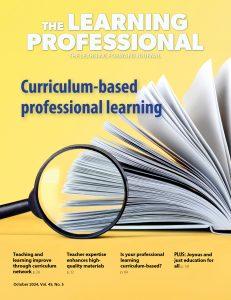The easiest and least effective way to address professional development is to provide one-size-fits-all professional learning opportunities, which means only a portion of attendees find it valuable. Many of us have sat through hours of professional development and, within the first five minutes, realized, “None of this applies to my subject area or grade level.”First, I admit that I have arranged bad professional learning for teachers in the past. Unfortunately, school leaders often look for presenters and initiatives that fill the time allotted. Most school districts have set aside days that are assigned to professional learning. Many administrators struggle to develop a professional learning program that is individualized and meaningful for all teachers.
This is the struggle for school leaders who plan professional learning opportunities for teachers. The goal of professional learning should be to change practice for the better. If the learning does not apply, then how will teachers change their practices for the better?
According to Jim Knight (2011), professional learning for teachers should provide opportunities to “explore, prod, stretch, and re-create whatever it is they are studying — to roll up their sleeves, really consider how they teach, really learn a new approach, and then reconsider their teacher practices and reshape the new approach, if necessary, until it can work in their classroom” (p. 43).
I doubt that we can meet the recommendations from Knight through a one-size-fits-all approach. Professional learning needs to occur throughout the school week and school year. There is a disconnect for the teacher when the learning is not part of the school day. Traditional sit-and-get professional development days are often held outside a school calendar. This structure rarely impacts instruction because it is not connected to a classroom and is not occurring throughout a school year.
Learning Forward has recommended that professional learning occur “several times per week among established teams of teachers, principals, and other instructional staff members where the teams of educators engage in a continuous cycle of improvement” (NSDC, 2009, p. 2).
Providing time for teacher collaboration and learning is one of the most powerful things schools can do to improve learning, but collaboration that lacks a focus will do nothing to improve schools (DuFour, DuFour, Eaker, & Many, 2006). We should start by critically examining the structure of a school day.
There is some belief that the school day needs to be lengthened to improve student achievement. We seem to think that if we have more time in front of kids, they will learn more. What if we reduce the amount of instructional time and build in teacher collaboration that is focused on improving instruction? Instead of focusing on quantity of instruction, we focus on quality of instruction.
We cannot expect collaboration to occur during teacher prep time, after school, during lunch, before school, etc. I believe we must embed a specific time for collaboration consistently across a district. This will help administrators support each professional learning community (PLC). This will also help with vertical meetings that will need to occur to address gaps and overlaps with curriculum, instruction, and assessment.
Meetings should occur at minimum once a week. If we aren’t meeting weekly, we forget about our focus, and it’s harder to get back on track and use time efficiently. We need to ensure that collaboration time is protected and considered sacred. People will try to consume this newly found collaboration time with meetings that do not matter. Administrators need to protect this time. That means no practices, activity meetings, or advisor meetings during collaboration. The only activities that occur during collaboration are those associated with a PLC.
We have targeted Wednesday morning for the day to implement PLCs. Wednesdays work well because there are typically fewer events and vacation days on Wednesday. We start school late on Wednesdays to avoid scheduled extracurricular and co-curricular activities. This allows coaches and advisors to take part in collaboration.
Starting school late has not been an issue for students and parents. We still allow students to be dropped off at their regular times. In elementary school, we have about 100 students that go to the library to read silently, read with a friend, or be read to. This has positively affected kids. Paraprofessionals supervise the remainder of our students.
During this time, our collaborative efforts focus on these key areas: unpacking standards, developing formative and summative assessments, defining mastery, scope, and sequence, intervention and enrichment, and a focus on data. One key area that is often overlooked is embedding learning within a PLC model. How are teachers seeking out best practices to support key areas mentioned above?
Put learning back into PLCs
Over the past three years, our professional learning committee has revamped our professional learning practices. It has been trial and error. Our professional learning committee meets monthly to discuss the following goals: How do we make professional learning more individualized? How do we make professional learning more meaningful for all?
Before these discussions, our learning was separate from our PLC work. We began to realize that our professional learning goals should be part of our PLC work. We believe high-quality professional learning practices merge our goals together.
During our work session in June 2014, our committee had a collective epiphany. To make professional learning more individualized and more meaningful, we needed to turn learning over to our teachers. Teachers needed to plan their learning for each year. This was an exciting breakthrough for us.
We decided to use our traditional professional development days in the following ways: Each individual PLC would develop its professional learning plan focused on improving student engagement. The professional learning plan consists of four parts: goal setting, research, observation and integrating of learning, and reflection.
1. Goal setting: The PLC meets during its collaboration time early in the year to establish a learning goal for the school. One of our school improvement goals focuses on improving student engagement. So the PLC learning goal is centered on improving student engagement.
2. Research: All PLCs are required to select at least one research-based book to study or at least three peer-reviewed recent research articles from academic journals. Journal articles are subject to approval by a professional development committee. We need to interweave research exploration into the daily practices of our teachers.
There are times when our own anecdotes override effective research-based practices because the research did not involve “my school” or “my kids,” or the teacher was not aware that there was a better, more proven way to do things. Analyzing effective research-based practices is one key to effective instruction.
3. Observation and integration of learning: The best professional development is focused, timely, and job-embedded. We wanted to make sure these ideas were entrenched throughout our plan. We provided two options for teachers to choose from: They could decide between a school visitation or take part in our peer observation program.
For a school visitation, teachers select a school within our state they would like to visit based on what they learned from research. We provide teacher substitutes, and the teachers travel as a team to a school and observe a teacher for a day using an instructional technique.
It is important to note that a research-based book or journal article needs to be aligned with a school visit. We want our teachers to see effective strategies live and bring those strategies back to our school for implementation. After a school visit is complete and research-based practices are implemented, teachers record themselves for a minimum of 15 minutes using the new strategy.
We added the peer observation program for those who didn’t want to do a school visitation. Instructional coaches lead the program. When PLC teams select this option, they work with an instructional coach to identify a problem of practice. The problem of practice should be tied to the team’s selected research-based book or journal articles. The instructional coach figures out the logistics to make sure that each teacher receives and gives feedback. The feedback needs to be descriptive and related to what teachers are implementing and cannot be ego-building feedback.
4. Reflective practice: Learning requires reflection. We felt that we needed teachers to reflect on their new learning near the end of the year. Last year, we added an opportunity for all teachers to receive a credit through one of our research institutions in North Dakota when they completed their professional learning plan. I believe strongly in written reflection. When we write down our thoughts, it deepens our understanding.
Freedom plus accountability
Teachers need autonomy and personalized learning to grow. We believe we have found the right combination of freedom and accountability within our professional learning plan. The plan makes professional learning more individualized and meaningful for a teacher.
When teams of teachers are given time to research best practices, observe other teachers, and reflect on what they’ve learned, they grow professionally. Changes we have made impacted our school culture in a positive way. Our teachers feel empowered and trusted to do this very difficult work.
References
Dufour, R., Dufour, R., Eaker, R., & Many, T. (2006). Learning by doing. Bloomington, IN: Solution Tree.
Knight, J. (2011). Unmistakable impact: A partnership approach for dramatically improving instruction. Thousand Oaks, CA: Corwin.
National Staff Development Council. (2009, April). Ensure great teaching for every student. NSDC Policy Points, 1(2), 1.
This column originally appeared in Learning Forward’s PD Watch and is also in the April 2017 issue of The Learning Professional, Learning Forward’s bimonthly member publication.





